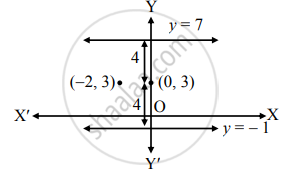Advertisements
Advertisements
प्रश्न
Write the equation of the line :
parallel to the X-axis and at a distance of 4 unit form the point (−2, 3)
उत्तर
Equation of a line parallel to the X-axis is of the form y = k (k > 0 or k < 0).
Since the line is at a distance of 4 units from the point (− 2, 3),
k = 4 + 3 = 7 or k = 3 – 4 = – 1
∴ The equation of the required line is y = 7 or y = – 1.

APPEARS IN
संबंधित प्रश्न
Obtain the equation of the line containing the point :
A(2, – 3) and parallel to the Y−axis
Line y = mx + c passes through points A(2, 1) and B(3, 2). Determine m and c.
The vertices of a triangle are A(3, 4), B(2, 0), and C(−1, 6). Find the equation of the line containing side BC.
The vertices of a triangle are A(3, 4), B(2, 0), and C(−1, 6). Find the equation of the line containing the median AD
The vertices of a triangle are A(3, 4), B(2, 0), and C(−1, 6). Find the equation of the line containing the midpoints of sides AB and BC
Find the x and y intercept of the following line:
`(3x)/2 + (2y)/3` = 1
Find the x and y intercept of the following line:
2x − 3y + 12 = 0
Find equations of lines which contains the point A(1, 3) and the sum of whose intercepts on the coordinate axes is zero.
Find the coordinates of the orthocenter of the triangle whose vertices are A(2, −2), B(1, 1), and C(−1, 0).
Select the correct option from the given alternatives:
The equation of the line through (1, 2), which makes equal intercepts on the axes, is
Answer the following question:
Does point A(2, 3) lie on the line 3x + 2y – 6 = 0? Give reason.
Answer the following question:
Obtain the equation of the line containing the point (2, 4) and perpendicular to the Y−axis
Answer the following question:
Find the equation of the line having slope 5 and containing point A(–1, 2).
Answer the following question:
The vertices of a triangle are A(1, 4), B(2, 3) and C(1, 6). Find equations of the sides.
Answer the following question:
The vertices of a triangle are A(1, 4), B(2, 3) and C(1, 6) Find equations of altitudes of ∆ABC
Answer the following question:
Find the equation of the line through A(−2, 3) and perpendicular to the line through S(1, 2) and T(2, 5)
Answer the following question:
Two lines passing through M(2, 3) intersect each other at an angle of 45°. If slope of one line is 2, find the equation of the other line.
Answer the following question:
The vertices of ∆PQR are P(2, 1), Q(−2, 3) and R(4, 5). Find the equation of the median through R.
Answer the following question:
The perpendicular from the origin to a line meets it at (−2, 9). Find the equation of the line.
Answer the following question:
Show that there are two lines which pass through A(3, 4) and the sum of whose intercepts is zero.
If the equation kxy + 5x + 3y + 2 = 0 represents a pair of lines, then k = ____________.
If (a, −2a), a > 0 is the mid-point of a line segment intercepted between the co-ordinate axes, then the equation of the line is ____________.
If for a plane, the intercepts on the co-ordinate axes are 8, 4, 4, then the length of the perpendicular from the origin to the plane is ______
The lines `(x + 1)/(-10) = (y + 3)/-1 = (z - 4)/1` and `(x + 10)/(-1) = (y + 1)/-3 = (z - 1)/4` intersect at the point ______
The point A(b, a) lies on the straight line 2x + 3y = 13 and the point B(a, b) lies on the straight line -x + 4y = 5, then the equation of line AB is ______
The intercept of a line between the coordinate axes is divided by the point (1, 3) in the ratio 3 : 1. The equation of the line will be ______
The line L given by `x/5+y/b=1` passes through the point (13, 32). The line K is parallel to L and its equation is `x/c+y/3=1`. Then, the distance between L and K is ______.
Area of the parallelogram formed by the lines y = mx, y = mx + 1, y = nx and y = nx + 1 is equal to ______.
